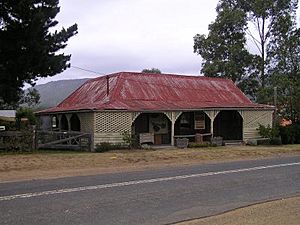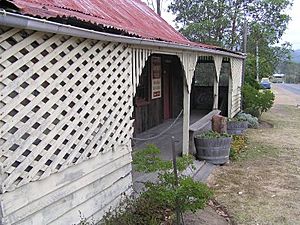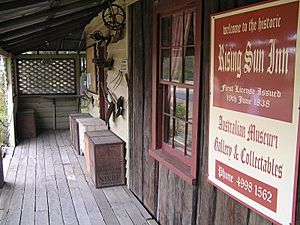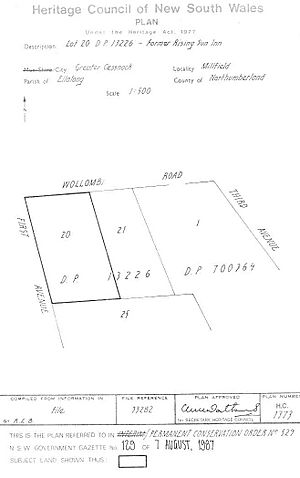Rising Sun Inn, Millfield facts for kids
Quick facts for kids Rising Sun Inn |
|
|---|---|
 |
|
| Location | 95-97 Wollombi Road, Millfield, City of Cessnock, New South Wales, Australia |
| Built | 1832–1838 |
| Official name: Rising Sun Inn (former) | |
| Type | state heritage (built) |
| Designated | 2 April 1999 |
| Reference no. | 529 |
| Type | Inn/Tavern |
| Category | Commercial |
| Builders | Unknown |
| Lua error in Module:Location_map at line 420: attempt to index field 'wikibase' (a nil value). | |
Rising Sun Inn is a very old building in Millfield, New South Wales, Australia. It was built a long time ago, between 1832 and 1838. Over the years, it has been many different things! It was once a place where people could stay (an inn), a post office, and even a general store. Today, it's a museum, a craft shop, and an art gallery. This special building is listed on the New South Wales State Heritage Register because of its important history.
Contents
History of the Rising Sun Inn
Building the Great North Road
In 1826, a very important road called the Great North Road was being built. About 300 convicts, who were prisoners used for labor, worked on this road. It stretched from Castle Hill to Maitland.
As the road was built, many inns (like hotels or pubs) opened along the way. These inns gave travelers and workers a place to rest. Pat Dowlan's Inn was one of the first, recorded in 1832. Near Millfield, there were at least five inns close by.
Millfield's Early Days
Millfield started as a small group of buildings on the Great North Road. It was named after a large flour mill that used to be there. Today, Millfield is more known for its sawmills.
The Rising Sun Inn was built around 1838. The land it stands on was given to William Smith in 1828. The first person to run the inn was John McDougall, starting in 1838.
Bushrangers and the Inn
John McDougall was known for being very strict with the convicts when he was their overseer on the Great North Road. An overseer was someone who supervised the workers.
It's believed that some convicts wanted to get back at McDougall. They pretended to be bushrangers and attacked the inn. In December 1840, a famous bushranger named Edward (Jew Boy) Davis and his gang held up the inn. They robbed the publican (the person running the inn), Thomas Pendergast, of 13 pounds. McDougall, who was visiting, was also attacked.
The Inn's Many Lives
In 1857, some reports said the inn was destroyed by fire. However, others believe it was the house next door that burned down. If the inn did burn, it was rebuilt very quickly. Just a few months later, there was a report of a theft from the Rising Sun Inn.
The building stayed an inn until about 1866. Then, a man named Charles Beany bought it and turned it into a general store. In the same year, the postal service moved to the inn, making it a post office too. From about 1895 to 1980, the building was used as a home by local families.
Restoring the Inn
By 1980, the building was quite old and run down. It was almost going to be knocked down. But then, restoration work began! This meant fixing it up carefully. All the windows and doors had to be replaced. Water and power were added, and the floor, which had sunk, was made level again.
Today, the Rising Sun Inn is a special place. It serves as a museum, where you can learn about its past. It's also an art gallery and a craft shop.
What the Rising Sun Inn Looks Like
The Rising Sun Inn is a simple, old-style cottage. It was built with vertical ironbark wood slabs for walls. It has a roof with two pointed sections. There's a verandah (a covered porch) at the front and sides, supported by timber posts.
The kitchen, which used to be a separate building, is now connected to the main building. It has a large brick fireplace.
The oldest part of the building, made of hardwood slabs, is thought to be from 1832. Later additions, like those made of weatherboard (wooden planks), were added in the late 1800s.
The building has changed quite a bit over its long history. The original part in the northwest corner still has its old vertical slab walls. Some of the floorboards in the original section have been replaced using wood from other parts of the building. In the 1980s, a laundry and bathroom were added.
Why the Rising Sun Inn is Important
The Rising Sun Inn is a rare and special building. It's one of the few examples of an inn built with wood slabs from the early 1800s. It was an important stop for travelers on the Great North Road. This road helped open up the Hunter Valley area.
The building still has parts from when it was built around 1838. It also shows how it changed over time, from an inn to a general store, a post office, and a home. It has links to the early families who lived in the Wollombi-Maitland area. Many people who ran the Rising Sun Inn also ran other inns nearby.
The inn is also in a beautiful spot, on a rise overlooking Wollombi Brook. It's considered one of the most important old buildings in the City of Cessnock.
The Rising Sun Inn was added to the New South Wales State Heritage Register on April 2, 1999. This means it's officially recognized as a place of historical importance.
Historical Significance
The Rising Sun Inn is a rare example of an old slab-built inn. It shows how important the Great North Road was for opening up the Hunter Valley. The building's different uses over time, from an inn to a store and a home, tell a story about the area's history.
Community Connection
The inn has a special connection to the community. It's located in a scenic spot, which adds to its value.
Rarity
The Rising Sun Inn is a rare example of an inn built with wood slabs from such an early time.
See also




